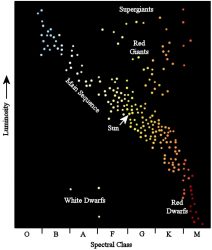Bwogger Olivia Mitchell heads to the newest edition of the Columbia Astronomy Lecture Series to find out why a scientist should never ask a star its age.

Hertzsprung-Russell Diagram
When I walked into the Pupin third floor lecture hall, the first thing I saw was a white powerpoint slide with the words “Never Ask a Star Its Age” in large font. Underneath the title was the night’s lecturer’s name: Mark Popinchalk. Popinchalk is currently an astrophysics graduate student at the CUNY Graduate Center and the American Museum of Natural History, where he is studying the rotation rates of low mass stars in K2. Popinchalk began the lecture with an outline that he pasted onto another powerpoint slide that hit the night’s four main topics: how different types of stars age, the basis of aging stellar clusters currently, observation approaches to understanding individual stellar ages, and gyrochronology. Before starting on the first subject, Popinchalk explained why the age of stars is important. Like humans, planets are also interested in the ages of stars, as they determine the space in which a planet is habitable. Take the sun, for example. All of the planets in our solar system orbit the sun–a star–and are placed in different zones of habitability. The Earth is currently in the habitable zone, meaning it is in the position where life can survive and water can exist. But as stars age, they also move. So while Earth is in the habitable zone now, Mars was also there in the past, and in 600 million years, Earth will no longer be in that same space. The habitability of a planet depends on the longevity of the stars around it, and as the stars move over their life span, it’s important to know a star’s age to determine the future of life in the solar system.
So, how can we tell how long a star will live? First, Popinchalk said, we have to take a look at the Hertzsprung-Russell diagram, which plots a star’s luminosity with its temperature. This graph shows that stars in the main point of their life follow the main sequence and the stars that are dying fall outside of it. Different stars will also fall outside of the main sequence, depending on their makeup and classification. As stars work through a balance between gravity and energy created, the specific amounts of gravity they experience and energy they exude is determined by their mass, which then determines their life span and classification. With more mass, there’s more gravity and therefore more energy. The more energy a star gives off, the shorter its lifespan. The 7 classifications of stars—O, B, A, F, G, K, and M—, which are determined by a star’s spectra and temperature, all have different life spans. In ascending order, O, the largest, live for 4 million years, B for 15 million years, A for 800 million years, F for 4.5 billion years, G for 10 billion years, K for 25 billion years, and M for 700 billion years.
Popinchalk continued, saying that the only reason we know stars are so old is because of an understanding of stars’ internal structures, called stellar structure, and can make predictions about a star’s luminosity and age. These stellar structures are shown in a model called an “isochrone”, which is a curve on the Hertzsprung-Russell diagram that represents a population of stars that are the same age. This curve is calibrated using the Sun’s age, which is found via the carbon dating of chondrite meteorites, which are the meteorites that make up the Sun. An isochrone represents and is tested by spectral clusters, which are groups of stars that were “born” together and move together for a while. Yet, Popinchalk says, as isochrones can only measure the age of stars in these groups, observational approaches must be used to understand a star’s individual age. This can be measured in four different ways: kinematics, magnetic activity, metallicity, and rotation rate.
Kinematics is the movement of stars over time. While stars are born into clusters, they do not stay there for their entire lives. At some point, they get kicked out, and the longer they’ve been around, the further they’ve been kicked. The magnetic activity of a star also changes over time, as the strength of their magnetic activity in their starspots decreases with age. For metallicity, when stars form from large clouds of gas that come from the deaths of other stars, they have a lot more metal in their cores, meaning that newer stars are richer in metals. The study of the rotation rate of stars to find their age, also known as gyrochronology, measures how fast a star is spinning, and it states that as a star spins and spits off winds, it loses angular momentum and slows down over time, meaning the slower the rotation, the older the star. Popinchalk continued to excitably explain how gyrochronology is measured by rotation and affected by distance. To measure a star’s rotation, scientists use dim starspots that rotate with the surface of the star, to look at the brightness over time, as stars undergo periodic brightening and darkening depending on how fast the spots and therefore the surface, is moving.
There are a lot of factors to take into account and systems of measurement to use when thinking about the age of a star. But regardless of the complexities of stellar structures and gyrochronology, we can always bank on the fact that stars are pretty damn old.
the fabric of our cosmos via Bwog Archives


 0 Comments
0 Comments